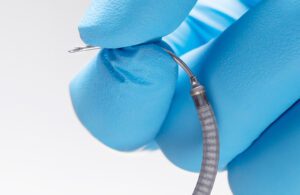
Intuitive President Dave Rosa [Photo courtesy of Intuitive]
Intuitive Surgical President Dave Rosa says he doesn’t get too excited by the idea of better robotic surgery graspers or more flexible wrists.
Instead, Rosa identified two technological opportunities that are going to advance surgical robotics and minimally invasive surgery in a major way: improved visualization for surgeons and focal therapy.
“How can we help surgeons see more about what they’re doing? … That, to me, is a huge piece of the puzzle going forward that I’m really excited about,” Rosa said in an interview with DeviceTalks Editorial Director Tom Salemi for our Intuitive Talks podcast.
DeviceTalks West: Intuitive President Dave Rosa will give a keynote interview in Santa Clara, California on Oct. 19
Improving visualization
The difference between the best and worst surgeons isn’t who can manipulate the instrument better, Rosa said, but rather who has better anatomical knowledge with regards to tissue planes, the subtleties of where bleeding might or might not happen, and the location of nerves or structures like the ureter.
The question is how can device developers help surgeons so they don’t need 1,000 cases to learn that sort of anatomical variation, Rosa said.
“Fluorescence-guided surgery is a big piece of this puzzle, where you can inject a fluorescing marker into the body and using infrared lasers in the system, it lights up. It’s pretty amazing,” Rosa said. “We have a molecule in development that’s specific to prostate cancer, for example. You can inject the drug, turn on the infrared laser, and see the prostate cancer. And if the surgeon has resected the prostate but happens to leave some behind, they can go back and resect that and work for a negative margin. That’s not possible in white light imaging.”
Rosa also mentioned hyperspectral imaging among other visualization technologies that can help surgeons better understand what they’re looking at.
Intuitive’s Da Vinci system already has an integrated capability called Firefly that uses near-infrared fluorescence imaging to help surgeons with cholecystectomy (gallbladder removal).
“Surgeons are using Firefly just to confirm they understand the anatomy. So now they can go in — in every case, every patient — confident that they’ll finish it minimally invasive,” Rosa said. “They have great imaging and they have great tools to do even a very difficult gallbladder that may have very difficult anatomy, whereas before they might go in and get it done sometimes, and not others and have to convert to open.”
Focal therapy
The second area Rosa highlighted is focal therapy, a less invasive treatment for prostate cancer. Focal therapy uses real-time imaging and ablation to destroy small tumors, minimizing the occurrence or severity of side effects from more traditional oncology therapies.
“As work is being done outside of Intuitive for liquid biopsy, better imaging, you see that cancer might be detected earlier, when it’s smaller and not symptomatic,” Rosa said. “If that’s true and you buy that as a thesis — I don’t think we’d argue that — it should be possible to treat it earlier, too, if we can localize it.”

Intuitive’s Flexision biopsy needle takes samples from deep inside the lung with the Ion robot-assisted endoluminal system. [Photo courtesy of Intuitive]
That kind of localized, focused therapy could be a good fit for surgical robotics and its advantages of precision and access. Rosa offered Intuitive’s Ion robotic-assisted bronchoscopy platform as an example of ways to potentially deliver focal therapy to tumors elsewhere in the body.
With Ion, he said, “you can get up into multiple generations of the lung, find a small lesion. Today it’s doing biopsy. But there’s a lot of work being done in how to ablate it.”
Intuitive as a minimally invasive care company
Intuitive is the world’s 22nd-largest medical device manufacturer, according to our latest Medtech Big 100 anking of device companies by revenue. But Focal therapy and imaging technology for robotic surgeries are two examples of how Rosa doesn’t think of Intuitive as a robotics company and maybe not even a medical device company, but more of a minimally invasive care company.
“It goes beyond the device, right? You could expand that term, but think about all the digital aspects of what’s happening: the integration of data, how we might use data, that isn’t necessarily the traditional definition of a device company, right? You’re usually selling some piece of hardware that has to go get sterilized. I have a minimally invasive care company that looks across a spectrum of advanced technologies and can integrate those up in a way that’s just going to make a difference.”